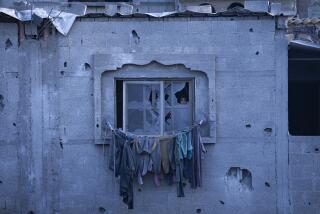Fearful Memories Still Haunt Budapest Square : Hungary: Nearly 70,000 Jews were forced into a ghetto 50 years ago. Unlucky ones were sent to death camps.
- Share via
BUDAPEST, Hungary — Klauzal Square. The air fills with the squeals of children and the squeak of playground swings. But David Gutmann remembers the square differently, as a dumping ground for the looted corpses of Jews.
Another part of Budapest, another Holocaust memory. Terez Virag was 14 when her grandmother perished in a gas chamber. Now 64, Virag understands another dimension of the horror: “I’m near her age and I want to live. How badly she, too, must have wanted to live!”
Fifty years ago, Budapest was a place of heart-wrenching drama for the nearly 70,000 Jews forced into a ghetto in a traditionally Jewish district on the east, or Pest, side of the Danube.
The drama had a villain and hero larger than life: Adolf Eichmann, Adolf Hitler’s executioner of Jews, who oversaw the slaughter, and Raul Wallenberg, the Swedish diplomat who saved thousands.
For all its individual tragedies, the story of the Budapest ghetto is also a story of survival. While 600,000 Hungarian Jews from outside the capital were transported to Nazi death camps and thousands died of hunger and cold in the ghetto, many thousands more lived. The Budapest ghetto was the only one of about a dozen large ones in Europe to survive the war.
For most people, half a century has obscured the terror that began in October, 1944, when fascists called the Arrow Cross overthrew dictator Miklos Horthy, who had tried to end the alliance with Hitler.
Atrocities against Jews had been relatively rare under Horthy, but the new regime threw Hungary’s Holocaust machinery into high gear.
Eichmann testified at his war crimes trial that the Arrow Cross was more efficient at genocide than the Gestapo, sending 600,000 Jews to death camps in Germany, Austria and Poland in less than five months.
“When the Final Solution was implemented, all those in the provinces were destroyed with lightning speed, the fastest anywhere,” said Randolph Braham, professor emeritus at the City University of New York and author of the “Politics of Genocide.”
Initially, the Jews of Budapest were protected by Wallenberg and other diplomats, who set up safe houses and issued passes. But they could not manage that forever, and the first straggling lines of Jews were forced into the ghetto in late November, 1944.
Marta Deri remembers that march, when she was 12. Like others, her group was escorted by a band of Arrow Cross thugs, some no older than 17, itching to kill.
“A 6- or 7-year-old girl stepped out of line in front of me,” Deri said, eyes misting as she absently stirred her coffee at a table a stone’s throw from the former ghetto. “They shot her. I can still see the apples rolling out of her backpack after she hit the ground.”
The first stop was Klauzal Square. There, the Jews were ordered to give up all their valuables. By the time Gutmann arrived, the frozen bodies of those who disobeyed were strewn on the ground.
“Those corpses there are Jews who tried to be smart with me,” Gutmann remembers a swaggering Arrow Cross youth telling him. “Now they are dead. And the same thing will happen to every dirty Jew I catch hiding his valuables.”
A few Jews used their “Aryan” looks to advantage. Laszlo Siklos, A blond, blue-eyed boy of 15, bluffed the Arrow Cross into issuing him identification papers and a rifle. He then escorted his mother past real Arrow Cross troops at the ghetto gates, telling them he had caught her escaping. In her backpack, she carried food for relatives inside the walls.
But most people in the ghetto had to subsist on whatever food the Germans and Arrow Cross allowed them, usually watery soup and a little bread.
By the time the Soviet army arrived in January, starvation and cold had killed many. Living and dead shared the dank cellars. Frozen bodies were dumped in Klauzal Square by the thousands because there was no room for burial.
The survivors barely made it. A plan to send hundreds of Nazi and Arrow Cross killers into the ghetto was canceled on Jan. 15, 1945, just two days before Soviet army tanks crashed through the wooden palisade that imprisoned the Jews.
“The first Soviet soldier to poke his head into our cellar was a kid of 24, yelling, ‘Nemyetsky, Nemyetsky (Germans, Germans)!’ and pointing his submachine gun every which way,” said Gyoergy Nadas, 63.
“He was afraid Germans were waiting in ambush. I felt life coursing back into me. I could finally hope that we could live again.”
Some were too far gone for emotion.
“I didn’t cry until a visit to the Wailing Wall in May, 1989,” Deri said of her moment of release on a trip to Israel. “All the horror came back in a rush, and I broke out in tears.
“Suddenly I realized how lucky I was to be alive.”
More to Read
Sign up for Essential California
The most important California stories and recommendations in your inbox every morning.
You may occasionally receive promotional content from the Los Angeles Times.










